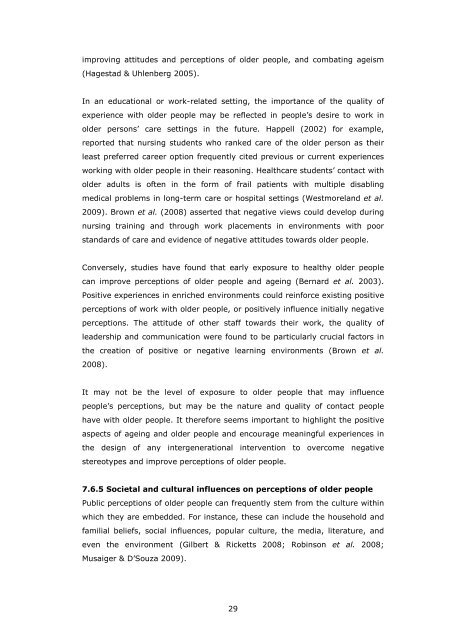Public Perceptions of Older People A literature review
Review 1 PP OP.pdf - National Centre for the Protection of Older ...
Review 1 PP OP.pdf - National Centre for the Protection of Older ...
You also want an ePaper? Increase the reach of your titles
YUMPU automatically turns print PDFs into web optimized ePapers that Google loves.
improving attitudes and perceptions <strong>of</strong> older people, and combating ageism<br />
(Hagestad & Uhlenberg 2005).<br />
In an educational or work-related setting, the importance <strong>of</strong> the quality <strong>of</strong><br />
experience with older people may be reflected in people’s desire to work in<br />
older persons’ care settings in the future. Happell (2002) for example,<br />
reported that nursing students who ranked care <strong>of</strong> the older person as their<br />
least preferred career option frequently cited previous or current experiences<br />
working with older people in their reasoning. Healthcare students’ contact with<br />
older adults is <strong>of</strong>ten in the form <strong>of</strong> frail patients with multiple disabling<br />
medical problems in long-term care or hospital settings (Westmoreland et al.<br />
2009). Brown et al. (2008) asserted that negative views could develop during<br />
nursing training and through work placements in environments with poor<br />
standards <strong>of</strong> care and evidence <strong>of</strong> negative attitudes towards older people.<br />
Conversely, studies have found that early exposure to healthy older people<br />
can improve perceptions <strong>of</strong> older people and ageing (Bernard et al. 2003).<br />
Positive experiences in enriched environments could reinforce existing positive<br />
perceptions <strong>of</strong> work with older people, or positively influence initially negative<br />
perceptions. The attitude <strong>of</strong> other staff towards their work, the quality <strong>of</strong><br />
leadership and communication were found to be particularly crucial factors in<br />
the creation <strong>of</strong> positive or negative learning environments (Brown et al.<br />
2008).<br />
It may not be the level <strong>of</strong> exposure to older people that may influence<br />
people’s perceptions, but may be the nature and quality <strong>of</strong> contact people<br />
have with older people. It therefore seems important to highlight the positive<br />
aspects <strong>of</strong> ageing and older people and encourage meaningful experiences in<br />
the design <strong>of</strong> any intergenerational intervention to overcome negative<br />
stereotypes and improve perceptions <strong>of</strong> older people.<br />
7.6.5 Societal and cultural influences on perceptions <strong>of</strong> older people<br />
<strong>Public</strong> perceptions <strong>of</strong> older people can frequently stem from the culture within<br />
which they are embedded. For instance, these can include the household and<br />
familial beliefs, social influences, popular culture, the media, <strong>literature</strong>, and<br />
even the environment (Gilbert & Ricketts 2008; Robinson et al. 2008;<br />
Musaiger & D’Souza 2009).<br />
29









